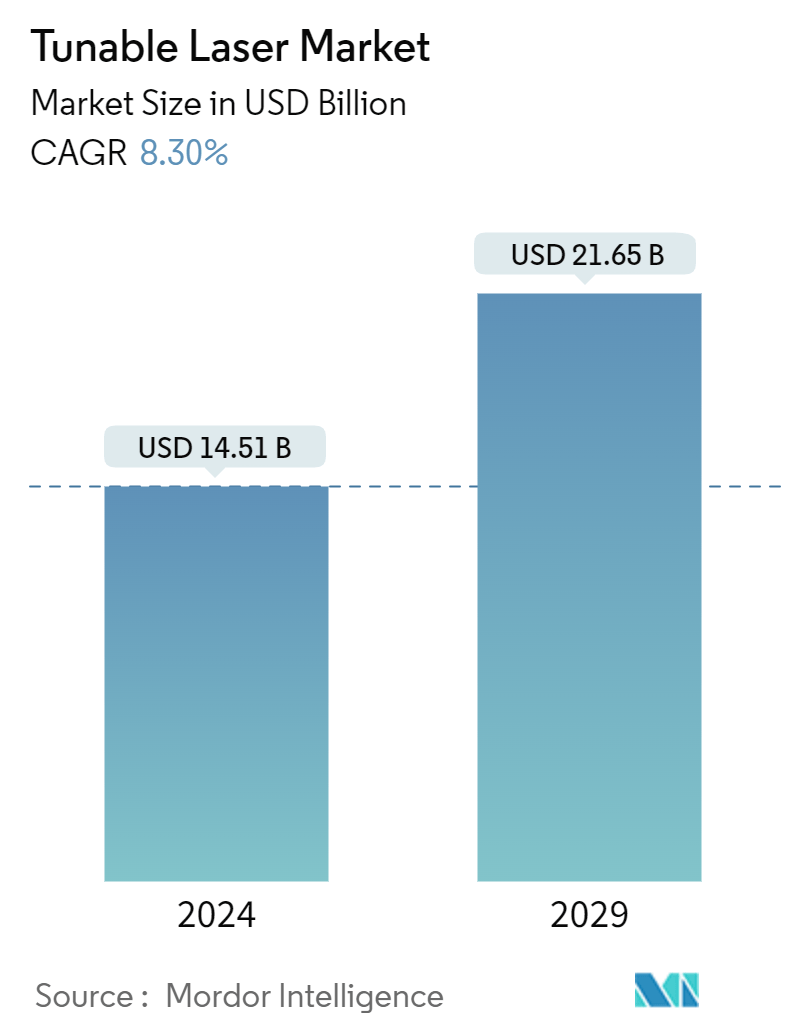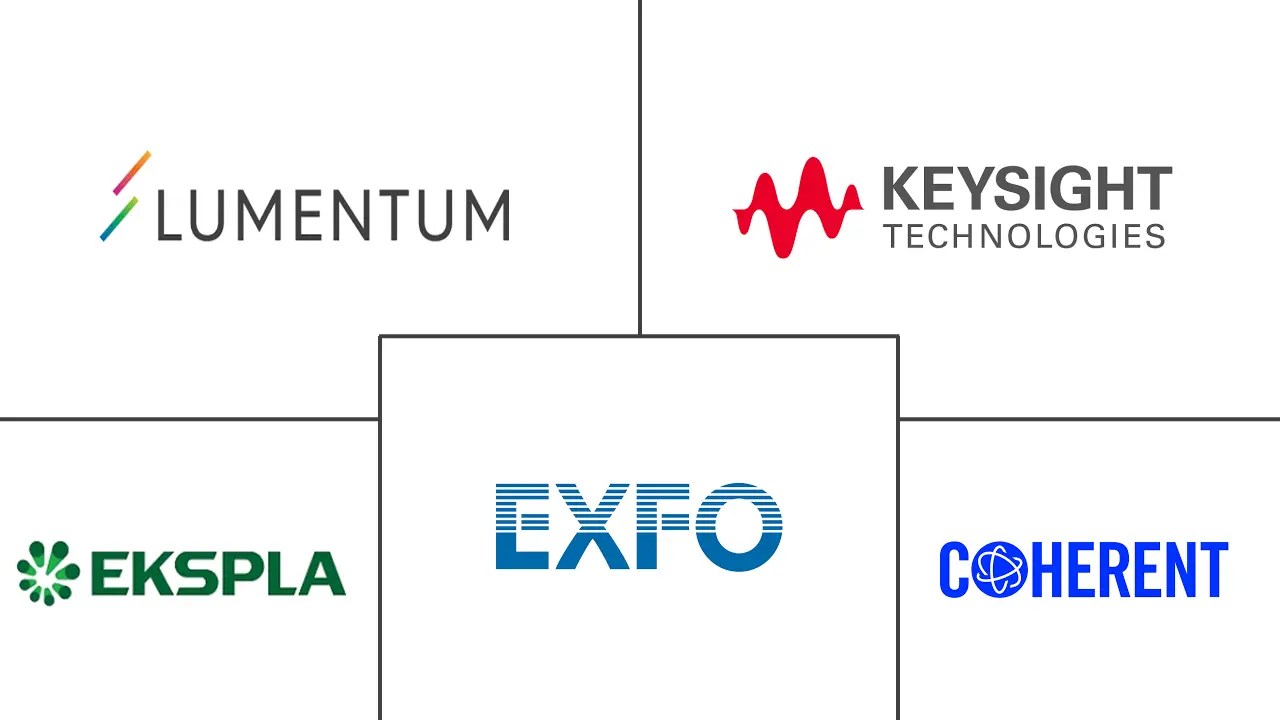Market Size of Tunable Laser Industry

| Study Period | 2024 - 2029 |
| Market Size (2024) | USD 14.51 Billion |
| Market Size (2029) | USD 21.65 Billion |
| CAGR (2024 - 2029) | 8.30 % |
| Fastest Growing Market | Asia Pacific |
| Largest Market | Asia Pacific |
Major Players
*Disclaimer: Major Players sorted in no particular order |
Tunable Laser Market Analysis
The Tunable Laser Market size is estimated at USD 14.51 billion in 2024, and is expected to reach USD 21.65 billion by 2029, growing at a CAGR of 8.30% during the forecast period (2024-2029).
Tunable lasers possess the ability to emit light at different wavelengths, making them very versatile. This flexibility enables them to adapt to various applications like spectroscopy, material processing, optical communications, etc. These lasers can be fine-tuned to match the specific requirements, providing robust control and precision. The lasers can emit a broad spectrum, from ultraviolet to infrared, allowing for a multitude of applications.
- Tunable lasers offer high resolution, allowing researchers to precisely study minute details. This level of resolution is crucial in fields like microscopy, where the ability to focus on specific structures or cells is paramount. By adjusting the laser's wavelength, efficient detail and clarity can be achieved.
- Tunable lasers offer cost-effective solutions in various industries. Compared to traditional fixed-wavelength lasers, tunable lasers eliminate the need for multiple lasers to cover a wide range of wavelengths. This consolidation reduces costs associated with maintenance, calibration, and power consumption.
- Additionally, the ability to reconfigure the laser's output wavelength eliminates the need for expensive hardware upgrades, making these lasers a more economical choice in the long run. They also offer high energy efficiency by converting the input energy into useful output light. This efficiency reduces power consumption, making tunable lasers an environmentally friendly choice.
- Tunable lasers are also being integrated with other technologies, such as optical fibers and integrated photonics. Combining these technologies allows tunable lasers to enable more complex and integrated systems. Further, the integration of tunable lasers with artificial intelligence (AI) holds great potential for optimizing laser performance. AI can be employed to automate the tuning process, enhance stability, and optimize laser parameters based on specific applications. This integration could enable more efficient and intelligent control of tunable lasers.
- However, the high initial cost associated with tunable lasers is one of the primary market restraints. The extensive R&D required to manufacture these lasers results in expensive production processes, making them unaffordable for many potential buyers. The high cost restricts the market to a niche customer base and limits the adoption of tunable lasers in various industries.
- Moreover, it presented new opportunities for growing data generation due to the increase in remote working environments. The remote working environment is leading to the growth in hyper-scale data centers, creating a need for efficient networking. Tunable lasers are essential for precise wavelength control in WDM systems. As the number of optical channels increases and smaller channel spacing is required, highly accurate tuning and filtering become necessary. Tunable lasers are also used in multiplexing and capacity expansions, as well as parallel single-mode architectures, coherent systems, dense wavelength division multiplexing (DWDM), etc.
- Various data center vendors are consistently investing in new data centers in line with the insatiable need for data. According to the National Association of Software and Service Companies (NASSCOM), India's data center market investment is expected to reach USD 4.6 billion in 2025. India's higher cost efficiency in both development and operation is its most significant advantage compared to more mature markets. Currently, India's data centers are mostly located in Mumbai, Bengaluru, Chennai, Delhi (NCR), Hyderabad and Pune. Calcutta, Kerala, and Ahmedabad are the upcoming data center hubs. These growing data center market investments drive the demand for data center infrastructure, including IT, electrical, mechanical, and general construction services in India.
Tunable Laser Industry Segmentation
The tunable lasers market is defined by the revenue generated from selling tunable lasers offered by different market players for a diverse range of end-user industries. The market trends are evaluated by analyzing the investments made in product innovation, diversification, and expansion. Further, the advancements in the telecommunications and manufacturing sectors are crucial in determining the growth of the market studied.
The tunable laser market is segmented by end-user industry (manufacturing and industrial sector, telecommunication and networking devices sector, healthcare sector, and other end-user industries) and geography (North America, Europe, Asia-Pacific, and Rest of the World). The market size and forecasts are provided in terms of value (USD) for all the above segments.
| By End-User Industry | |
| Manufacturing and Industrial Sector | |
| Telecommunication and Networking Devices Sector | |
| Healthcare Sector | |
| Other End-user Industries |
| By Geography | |
| North America | |
| Europe | |
| Asia | |
| Australia and New Zealand | |
| Latin America | |
| Middle East and Africa |
Tunable Laser Market Size Summary
The tunable laser market is poised for significant growth, driven by their versatility and adaptability across various applications such as spectroscopy, material processing, and optical communications. These lasers, capable of emitting light across a broad spectrum from ultraviolet to infrared, offer high resolution and precision, making them indispensable in fields like microscopy and healthcare. Their ability to be fine-tuned for specific requirements not only enhances control and detail but also provides cost-effective solutions by reducing the need for multiple fixed-wavelength lasers. This consolidation leads to lower maintenance, calibration, and power consumption costs, making tunable lasers an economically and environmentally friendly choice. The integration of tunable lasers with technologies like optical fibers, integrated photonics, and artificial intelligence further amplifies their potential, enabling more complex and intelligent systems.
The market's expansion is also fueled by increasing demand in sectors such as healthcare, where tunable lasers are used for non-invasive imaging and precise medical procedures. The rising prevalence of chronic diseases and the aging population are driving the need for innovative medical technologies, thereby propelling market growth. Additionally, the surge in data generation and the expansion of data centers, particularly in regions like Asia-Pacific, underscore the critical role of tunable lasers in enhancing data communication and processing capabilities. Despite the high initial costs and niche market limitations, ongoing advancements and strategic investments by key players are expected to drive further innovation and market penetration. The fragmented nature of the market, with numerous global and regional players, indicates a competitive landscape where companies are actively pursuing partnerships, product innovations, and market expansions to strengthen their positions.
Tunable Laser Market Size - Table of Contents
-
1. MARKET INSIGHTS
-
1.1 Market Overview
-
1.2 Industry Value Chain Analysis
-
1.3 Industry Attractiveness - Porter's Five Forces Analysis
-
1.3.1 Bargaining Power of Suppliers
-
1.3.2 Bargaining Power of Buyers
-
1.3.3 Threat of New Entrants
-
1.3.4 Threat of Substitutes
-
1.3.5 Intensity of Competitive Rivalry
-
-
1.4 Impact of COVID-19 Aftereffects and Other Macroeconomic Factors on the Market
-
-
2. MARKET DYNAMICS
-
2.1 Market Drivers
-
2.1.1 Increased Demand for Tunable Diode Laser Gas Analyzer
-
2.1.2 Demand for Spectroscopy Equipment in Life Science Study
-
-
2.2 Market Restraints
-
2.2.1 Complexity in System Design and Function
-
-
-
3. MARKET SEGMENTATION
-
3.1 By End-User Industry
-
3.1.1 Manufacturing and Industrial Sector
-
3.1.2 Telecommunication and Networking Devices Sector
-
3.1.3 Healthcare Sector
-
3.1.4 Other End-user Industries
-
-
3.2 By Geography
-
3.2.1 North America
-
3.2.2 Europe
-
3.2.3 Asia
-
3.2.4 Australia and New Zealand
-
3.2.5 Latin America
-
3.2.6 Middle East and Africa
-
-
Tunable Laser Market Size FAQs
How big is the Tunable Laser Market?
The Tunable Laser Market size is expected to reach USD 14.51 billion in 2024 and grow at a CAGR of 8.30% to reach USD 21.65 billion by 2029.
What is the current Tunable Laser Market size?
In 2024, the Tunable Laser Market size is expected to reach USD 14.51 billion.

